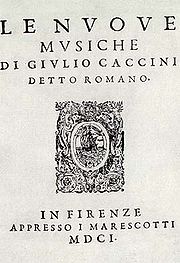
Le nuove musiche
Encyclopedia

Monody
In poetry, the term monody has become specialized to refer to a poem in which one person laments another's death....
and songs for solo voice and basso continuo by the composer Giulio Caccini
Giulio Caccini
Giulio Caccini , also known as Giulio Romano, was an Italian composer, teacher, singer, instrumentalist and writer of the very late Renaissance and early Baroque eras. He was one of the founders of the genre of opera, and one of the single most influential creators of the new Baroque style...
, published in Florence in July 1602. It is one of the earliest and most significant examples of music written in the early baroque
Baroque music
Baroque music describes a style of Western Classical music approximately extending from 1600 to 1760. This era follows the Renaissance and was followed in turn by the Classical era...
style of the seconda pratica
Seconda pratica
Seconda prattica, literally "second practice", is the counterpart to prima pratica and is more commonly referred to as Stile moderno. The term "Seconda prattica" was coined by Claudio Monteverdi to distance his music from that of e.g...
. It contains 12 madrigal
Madrigal (music)
A madrigal is a secular vocal music composition, usually a partsong, of the Renaissance and early Baroque eras. Traditionally, polyphonic madrigals are unaccompanied; the number of voices varies from two to eight, and most frequently from three to six....
s and 10 aria
Aria
An aria in music was originally any expressive melody, usually, but not always, performed by a singer. The term is now used almost exclusively to describe a self-contained piece for one voice usually with orchestral accompaniment...
s.
The volume was dedicated to Lorenzo Salviati and is dated February 1601; it was to be published early in 1602 but the printer, Giulio Marescotti, died before publication was completed, and its release was delayed until July of 1602.
The introduction to this volume is probably the most clearly written description of the purpose, intent and correct performance of monody from the time. It includes musical examples of ornaments—for example, how a specific passage can be ornamented in several different ways, according to the precise emotion that the singer wishes to convey. Caccini expressed disappointment at inappropriate ornamentation by the singers of his day. The preface also includes effusive praise for the style which he himself invented, and amusing disdain for the work of more conservative composers of the period.
An abridged English translation of Le nuove musiche
John Playford
John Playford was a London bookseller, publisher, minor composer, and member of the Stationers' Company, who published books on music theory, instruction books for several instruments, and psalters with tunes for singing in churches...
's Introduction to the Skill of Music from 1664 to 1694. Le nuove musiche

